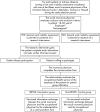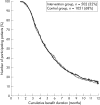Does enhanced information exchange between social insurance physicians and occupational physicians improve patient work resumption? A controlled intervention study
- PMID: 16551761
- PMCID: PMC2092510
- DOI: 10.1136/oem.2005.020545
Does enhanced information exchange between social insurance physicians and occupational physicians improve patient work resumption? A controlled intervention study
Abstract
Background: Patient work resumption after sickness absence varies even among patients with similar pathologies and characteristics. Explanations remain uncertain. One newly investigated field is "information asymmetry", a situation in which critical information is not appropriately exchanged between stakeholders in disability management. It is hypothesised that information asymmetry between social insurance physicians and occupational physicians prolongs sickness absence.
Objectives: To assess the influence of enhanced information exchange between these physicians on patient outcome.
Methods: Non-randomised controlled intervention study. The setting was the work inability assessment consultation of social insurance physicians in Belgium. Inclusion criteria were: employee, age 18-50, and subacute (more than one month) sickness absence. The intervention was a structured information exchange (through the use of a communication form) between the patient's social insurance physician and occupational physician. The intervention started when the patient's sickness absence reached the subacute stage, and ended when the sickness absence benefit was ceased or the duration exceeded one year. The primary outcome measure was the sickness absence benefit status of the patient assessed one year after benefit onset.
Results: Of the 1883 patients asked to enroll in the study, 1564 (84%) participated; 505 (32%) of 1564 patients were assigned to the intervention group and 1059 (68%) to the control group; 1553 (99%) of 1564 patients completed the study. In the intervention group, 86% received no sickness absence benefit at the end of the study, versus 84% in the control group (95% CI 0.91-1.15). No significant differences in other outcome parameters were obtained.
Conclusions: Information exchange between physicians may not be enough to influence work resumption among patients on sickness absence. Further research on stakeholders' information asymmetry and its effect on the outcome of patients are necessary. The complexity of information asymmetry in disability management cannot be underestimated.
Conflict of interest statement
Competing interests: none
References
-
- Williams R M, Westmorland M. Perspectives on workplace disability management: a review of the literature. Work 20021987–93. - PubMed
-
- Krause N, Lund T. Returning to work after occupational injury. In: Barling J, Frone M, eds. The psychology of workplace safety. Washington: APA Books, 2003
-
- Turner J, Franklin G, Turk D. Predictors of chronic disability in injured workers: a systematic literature synthesis. Am J Ind Med 200038707–722. - PubMed
-
- Tveito T H, Hysing M, Eriksen H R. Low back pain interventions at the workplace: a systematic literature review. Occup Med 2004543–13. - PubMed
Publication types
MeSH terms
LinkOut - more resources
Full Text Sources


